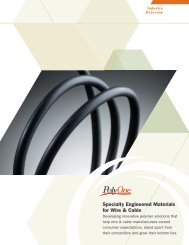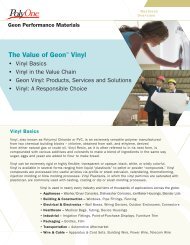TSR50 Extruding Flexible Geon Vinyls into Profiles - PolyOne
TSR50 Extruding Flexible Geon Vinyls into Profiles - PolyOne
TSR50 Extruding Flexible Geon Vinyls into Profiles - PolyOne
You also want an ePaper? Increase the reach of your titles
YUMPU automatically turns print PDFs into web optimized ePapers that Google loves.
Technical Service Report No. 50 - Page 1 of 2<br />
EXTRUDING FLEXIBLE GEON ® VINYLS INTO PROFILES<br />
INTRODUCTION<br />
<strong>Flexible</strong> PVC compounds consist of resins, plasticizers, stabilizers, lubricants, and may contain fillers and color pigments. Therefore,<br />
transparent, natural and precolored compounds can be formulated. Other modifiers such as processing aids, flame retardants, fungicides, etc.,<br />
can also be used.<br />
Resins are basic in determining mechanical and processing properties. Plasticizers have a major influence on the final properties of a compound,<br />
including tensile, elongation, low temperature brittleness, insulation resistance, retention of properties on aging, flame resistance, etc. There are<br />
many plasticizers available that are used to impart certain properties. Often a mixed plasticizer system is used to obtain a desired combination of<br />
properties.<br />
EXTRUSION EQUIPMENT<br />
A typical extrusion line consists of an extruder, die, sizing and cooling equipment, take off (puller), and a method of cutting the profile.<br />
EXTRUDER REQUIREMENTS<br />
The extruder barrel should have a length to diameter ratio of 24:1. The barrel should be lined with a chemical and wear resistant material such as<br />
Xaloy 101.<br />
The power section is made up of the motor and driving mechanisms. Care should be taken to ensure that the extruder is supplied with enough<br />
horsepower and gearing to operate efficiently.<br />
SCREW DESIGN<br />
The screw should be single flighted, constant pitch, with the pitch equal to the diameter and the length equal to 24 diameters. It should be bored for<br />
cooling. Screw flights should be flame hardened or capped with Colmonoy 56. The screw should be AISI-4140 chrome plated.<br />
Since flexible PVC compounds can cover a wide range of hardnesses, the screw design and dimensions are less critical than for rigid PVC.<br />
Some starting point recommendations for screws are:<br />
Diameter Inches Feed Transition Metering Compression Ratio<br />
2 1/2"<br />
3 1/2"<br />
4 1/2"<br />
0.350"-5 Flights<br />
0.450"-5 Flights<br />
0.550"-5 Flights<br />
12<br />
12<br />
12<br />
0.117-0.140"-7 Flights<br />
0.150-0.180"-7 Flights<br />
0.180-0.220"-7 Flights<br />
3.0-2.5<br />
3.0-2.5<br />
3.0-2.5<br />
Mixing pins and other types of mixing sections are often incorporated in a screw design to enhance dispersion, especially when adding color<br />
concentrates to a natural based compound. Screws with mixing pins typically have 12-14 flights in the metering section.<br />
Barrier screws, with and without Maddox mixing sections are still another type of design that can be used for extruding flexible PVC.
Technical Service Report No. 50 - Page 2<br />
BREAKER PLATES AND SCREENS<br />
Breaker plates are required to prevent the melt from twisting in the die, thus avoiding swirls in the product. Screens packs are recommended.<br />
They may be used to increase the pressure and temperature, or improve the surface appearance. Screen packs should be stainless steel.<br />
When multiple screens are used, always put the coarser screen against the breaker plate to back up the finer screens. A 20/40 mesh screen<br />
combination is a good starting point; finer mesh screens can then be added as required.<br />
Use a breaker plate made of Armco 17-4PH, 15-PH, or Carpenter Cartech Custom 450, hardened and polished. Avoid carbon steel, aluminum<br />
or brass, which can lead to degradation of the PVC. Entrance and exit should be chamfered to avoid stagnation.<br />
DIES FOR FLEXIBLE PVC<br />
Profile dies for extruding flexible PVC are designed on similar principles to those for rigid PVC. Refer to Technical Service Report No. 9 "Basic<br />
Die Design Concepts for <strong>Extruding</strong> Rigid <strong>Geon</strong> Vinyl" for various design parameters.<br />
COOLING AND SIZING<br />
<strong>Flexible</strong> PVC profiles are typically cooled by water immersion. Various types of sizing fixtures, such as sleeves, finger sizers, jigs, etc., are<br />
used to maintain the desired shape.<br />
TROUBLE SHOOTING GUIDE FOR PROFILE<br />
EXTRUSIONS MADE WITH FLEXIBLE GEON ® VINYLS<br />
PROBLEM<br />
POSSIBLE CAUSE<br />
Low Production Rates • Metering depth of screw to shallow.<br />
• Worn screw resulting in excessive<br />
clearance between screw and barrel.<br />
Voids just below surface sometimes<br />
giving a rough or grainy surface<br />
Voids generally<br />
throughout the entire<br />
cross sectional area<br />
Melt viscosity too low<br />
(soupy)<br />
• Moisture in material from improper<br />
storage or high humidity.<br />
• Trapped air from rear zone temperatures<br />
being too high.<br />
• Screw design contributing to low back pressure.<br />
• Screw design to severe.<br />
• Barrel zone temperatures too high.<br />
• Breaker plate holes too small.<br />
Stock temperature too low • Metering depth in screw too deep.<br />
• Barrel zone temperatures too low.<br />
• Screen packs to coarse.<br />
• Screw RPM too low.<br />
Lump extrusion • Stock temperature too low.<br />
• Die back pressure too low due heavy wall profile.<br />
• Screen packs too coarse.<br />
<strong>PolyOne</strong> © Corporation, 1994<br />
<strong>PolyOne</strong> © Corporation<br />
The information contained herein is believed to<br />
be reliable, but no representations, guarantees<br />
or warranties of any kind are made as to its<br />
accuracy, suitability for particular applications<br />
or the results to be obtained therefrom. The<br />
information is based on laboratory work with<br />
small-scale equipment and does not<br />
necessarily indicate end product performance.<br />
Because of variations in methods, conditions<br />
and equipment used commercially in<br />
processing these materials, no warranties or<br />
guarantees are made as to suitability of the<br />
products for the application disclosed. Fullscale<br />
testing and end product performance are<br />
the responsibility of the user. <strong>PolyOne</strong> shall not<br />
be liable for and the customer assumes all risk<br />
and liability of any use or handling of any<br />
material beyond <strong>PolyOne</strong>'s direct<br />
control. POLYONE MAKES NO WARRANTIES,<br />
EXPRESS OR IMPLIED, INCLUDING, BUT<br />
NOT LIMITED TO, THE IMPLIED<br />
WARRANTIES OF MERCHANTABILITY AND<br />
FITNESS FOR A PARTICULAR PURPOSE.<br />
Nothing contained herein is to be considered as<br />
permission, recommendation, nor as an<br />
inducement to practice any patented invention<br />
without permission of the patent owner.<br />
Printed in U.S.A. <strong>PolyOne</strong> Corporation April 1994



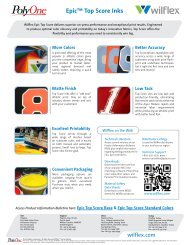

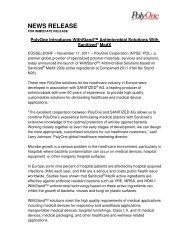
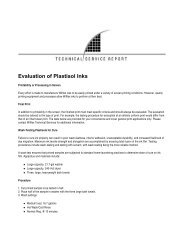
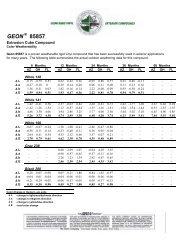
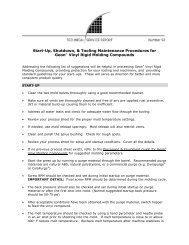
![TPE Injection Molding Guide [PDF] - GLS Thermoplastic Elastomers](https://img.yumpu.com/26329362/1/190x245/tpe-injection-molding-guide-pdf-gls-thermoplastic-elastomers.jpg?quality=85)

